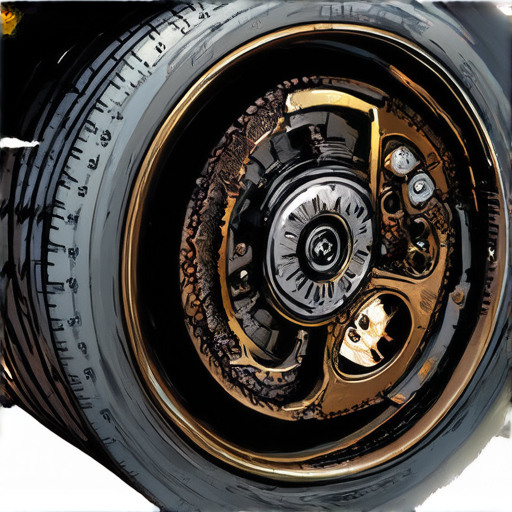When it comes to customizing your vehicle’s appearance, one crucial aspect often overlooked is proper wheel fitment. Ensuring that your new wheels fit perfectly can greatly impact both aesthetics and performance, but navigating the complex world of wheel measurements, offsets, and calculators can be daunting even for seasoned enthusiasts.

Ensuring Proper Wheel Fitment
To determine the correct fitment for your wheels, you’ll need to consider several factors.
- Suspension Type:
- Ride Height:
- Driving Conditions:
- Tire Size:
- Alignment:
- Fender Modifications:
Researching fitment setups from other vehicle owners can provide valuable insights into what works well for specific types of vehicles and stances.
Understanding Wheel Fitment Calculators
A wheel fitment calculator can help you determine the optimal offset, width, and other specifications for your wheels based on your vehicle’s unique characteristics.
- Determine your vehicle’s make, model, and year.
- Select the type of wheels you’re interested in (e.g., forged, cast, or chrome).
- Choose the desired offset, width, and other specifications.
- The calculator will provide you with a list of recommended wheels that meet your criteria.
Evaluating Fitment Options
When evaluating fitment options, consider the following factors:
- Clearance between the wheel and brake components.
- Space available for the wheel and tire combination.
- Desired stance and aesthetic appeal.
- Performance and handling considerations.
Consulting with Experts
If you’re unsure about the best fitment option for your vehicle, consult with experts in the field, such as wheel manufacturers, tuners, or experienced enthusiasts.
Additional Resources
For more information on wheel fitment and customization, visit our wheel fitment guide or check out our custom wheel design services.
We also recommend visiting reputable online forums and communities, such as r/offsetwheels or CarSO Official, to connect with other enthusiasts and learn from their experiences.
Understanding Wheel Sizes: What Does 17×7 Mean for Rims?
When it comes to selecting the perfect set of rims for your vehicle, understanding wheel sizes can seem overwhelming.
-
Wheel sizes are typically measured in inches and are represented by two numbers separated by an “x.”
-
The first number represents the diameter of the rim, which is the distance across the widest part of the wheel.
-
The second number represents the width of the rim, which is the distance between the two edges of the wheel.
In the case of a 17×7 rim, the first number (17) indicates that the diameter of the rim is 17 inches, while the second number (7) indicates that the width of the rim is 7 inches.
Why Is Wheel Size Important?
Choosing the right wheel size is crucial for several reasons:
-
It affects the overall look and style of your vehicle.
-
It impacts the performance and handling of your vehicle.
-
It influences the fitment of your tires.
Tire Fitment Considerations
When selecting a wheel size, it’s essential to consider the tire fitment requirements of your vehicle.
-
A larger wheel size may require a wider tire to maintain proper clearance and prevent rubbing issues.
-
A smaller wheel size may require a narrower tire to ensure proper fitment and prevent excessive clearance.
Popular Wheel Sizes
Some popular wheel sizes include:
-
15×6.5
-
16×7
-
17×8
-
18×9.5
Conclusion
In conclusion, understanding wheel sizes is crucial for selecting the perfect set of rims for your vehicle.
By considering factors such as diameter, width, and tire fitment, you can choose a wheel size that meets your needs and enhances the overall performance and style of your vehicle.

How to Find the Correct Wheel Offset
At Incubus Wheels, we understand the importance of choosing the right wheel offset for your vehicle.
- Definition of Wheel Offset: Wheel offset refers to the distance between the centerline of the wheel and the hub mounting surface.
- Why is Wheel Offset Important? A correct wheel offset ensures proper clearance between the tire and suspension components, preventing damage and improving overall handling and safety.
- Measuring Wheel Offset: To determine the correct wheel offset, follow these steps:
- Place a solid, flat item, such as a board, across the wheel so that there’s a flat surface touching both sides of the wheel.
- Using a ruler or tape measure, measure the distance from the mounting surface to the base of the object.
- Record the measurement, which represents the wheel offset.
For example, a wheel with a +35mm offset means that the centerline of the wheel is 35mm further out from the hub mounting surface compared to the standard position.
When selecting wheels, consider factors such as:
- Tire Size and Type: Different tire sizes and types require varying wheel offsets to ensure proper fitment.
- Vehicle Make and Model: Consult your vehicle’s manufacturer specifications for recommended wheel offset ranges.
- Personal Preference: Consider aesthetics and personal style when choosing wheel offset.
At Incubus Wheels, we offer a wide selection of custom wheels with various offset options to suit your needs.
Remember to consult with our experts before making a purchase to ensure the correct wheel offset for your vehicle.
Visit our website at https://incubus-wheels.com/ to explore our collection and learn more about wheel offset.
We also recommend checking out reputable sources such as Discount Tire for additional information on wheel offset and tire selection.
By choosing the right wheel offset, you’ll enjoy improved handling, safety, and overall driving experience.

Understanding Wheel Factory Offset
The factory offset of your wheels refers to the distance between the centerline of the wheel and its hub mounting surface.
- Offset Measurement: The offset measurement is usually indicated on the wheel’s sidewall or on the manufacturer’s documentation.
- ET Designation: The ET designation stands for “et” which is short for “European Thread,” indicating the offset measurement in millimeters.
- Positive vs Negative Offset: A positive offset means the hub mounting surface is positioned closer to the front of the wheel, while a negative offset means it’s positioned closer to the back.
- Why Offset Matters: The correct offset ensures proper tire clearance, handling, and overall vehicle stability.
How to Determine Your Wheel’s Factory Offset
- Check the wheel’s sidewall for the offset measurement, typically marked with the ET designation.
- Consult your vehicle’s owner’s manual or manufacturer’s documentation for specific offset recommendations.
- Measure the distance between the centerline of the wheel and its hub mounting surface using a ruler or caliper.
- Compare your measurements to the recommended offset values for your vehicle.
Tips for Choosing the Right Offset
- Consider Your Vehicle’s Make and Model: Different vehicles have unique offset requirements, so consult your owner’s manual or manufacturer’s guidelines.
- Think About Tire Size and Type: Larger tires may require a different offset than smaller ones, and certain tire types (e.g., low-profile) may need special consideration.
- Don’t Forget About Suspension and Steering: Incorrect offset can affect suspension geometry and steering alignment, leading to reduced handling and safety issues.
Conclusion
Determining your wheel’s factory offset is crucial for ensuring proper fitment, handling, and safety. By understanding how to measure and choose the right offset, you’ll be able to select the perfect wheels for your vehicle and enjoy a smoother, more stable ride.
Does Negative Offset Stick Out More?
When it comes to wheel offset, understanding the difference between positive and negative offset can greatly impact the overall look and functionality of your vehicle.
- Positive Offset: A positive offset occurs when the mounting flange is pushed closer towards the outer lip of the wheel, resulting in a recessed or sunken appearance.
- Negative Offset: Conversely, a negative offset takes place when the mounting flange is positioned further inward from the wheel’s centerline, causing the wheel to protrude further from the body.
Visual Impact of Negative Offset
The visual impact of negative offset is often more noticeable compared to positive offset due to its protruding nature.
- Increased Clearance: With a negative offset, there is typically less clearance between the wheel and the surrounding components, making it more prone to rubbing against suspension components or brake calipers.
- Aesthetics: The protruding nature of negative offset wheels can give a more aggressive stance to a vehicle, but it may not be suitable for everyone’s taste.
Key Considerations for Negative Offset
Before opting for negative offset wheels, consider the following factors:
- Clearance Issues: As mentioned earlier, negative offset wheels have reduced clearance, increasing the risk of rubbing against surrounding components.
- Brake Caliper Clearance: Ensure that the brake calipers have sufficient clearance to accommodate the negative offset wheels.
- Suspension Component Clearance: Verify that the suspension components have enough clearance to prevent damage or interference.
Alternatives to Negative Offset
If you’re concerned about the visual impact of negative offset or want to minimize clearance issues, consider the following alternatives:
- Positive Offset: Opt for positive offset wheels, which provide a recessed appearance and increased clearance.
- Custom Wheels: Design custom wheels with a balanced offset that suits your vehicle’s needs and aesthetic preferences.
Conclusion
In conclusion, negative offset wheels can indeed stick out more due to their protruding nature, but it’s essential to weigh the pros and cons before making a decision.
Consider clearance issues, brake caliper clearance, and suspension component clearance before opting for negative offset wheels.
Ultimately, choose the wheel configuration that balances aesthetics, functionality, and safety for your vehicle.

Understanding Acceptable Wheel Offset
When it comes to upgrading your vehicle’s wheels, understanding the acceptable offset is crucial to ensure proper fitment and functionality.
- Definition: Wheel offset refers to the distance between the centerline of the wheel and the hub mounting surface.
- Importance: Proper wheel offset ensures correct clearance between the wheel and the brake caliper, as well as optimal tire wear and handling characteristics.
- Factors to Consider: When selecting new wheels, consider the following factors:
- Backspacing: The distance between the wheel’s rim and its hub mounting surface.
- Offset: The distance between the wheel’s centerline and its hub mounting surface.
- Tire size and type: Different tires have varying diameters and widths, affecting the overall wheel diameter and offset requirements.
- Vehicle specifications: Consult your vehicle’s manufacturer guidelines for recommended wheel offset and backspacing.
- General Guidelines: As a general rule, it’s recommended to stick to the original equipment manufacturer’s (OEM) specified wheel offset and backspacing values. However, if you’re upgrading to larger wheels, you may need to adjust the offset accordingly.
- Maximum Offset Difference: To minimize potential issues, aim to keep the new wheel’s offset within 5mm of the original offset.
- Wider Wheels: When installing wider wheels, factor in increased backspacing to maintain proper clearance and prevent rubbing issues.
- Best Practices: To ensure smooth installation and optimal performance, follow these best practices:
- Consult with a professional mechanic or wheel specialist for personalized recommendations.
- Verify the wheel’s compatibility with your vehicle’s make and model before purchasing.
- Double-check the wheel’s specifications against your vehicle’s OEM guidelines.
By understanding the importance of wheel offset and considering the factors mentioned above, you can ensure a safe and successful upgrade to your vehicle’s wheels.

0 Comments